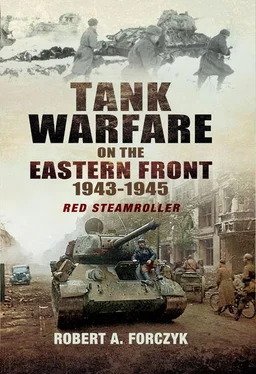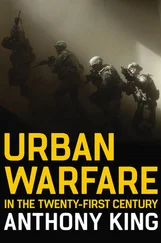Although Golikov’s Voronezh Front was still advancing against Armeeabteilung Kempf with the 40th and 69th Armies, the Stavka recognized that Vatutin’s Southwest Front had suffered a major reverse. Golikov used Vatutin’s defeat to temporarily shift to the defence, allowing his exhausted forces a brief respite, but on 28 February the Stavka ordered him to send Rybalko’s 3TA south from Kharkov to block Hoth’s armour from approaching Kharkov. Given the lack of intelligence about the SS-Panzerkorps’ dispositions, poor logistics and lack of air support, this was a foolish decision. Furthermore, Rybalko barely had 60 operational tanks left between his two tank corps, including at least five Matildas and 20–30 T-70 light tanks, but the Stavka had no replacements immediately available. Indeed, this inability of the Stavka to ensure a steady flow of tank replacements to the front in February–March 1943 illustrates a point that is often lost in macro-level assessments of the Eastern Front, namely that the Soviet Union was out-producing Germany in tanks, but could not always deploy this numerical superiority at the right time and place on the battlefield. At this point, the Stavka had no significant armoured reserves and was forced to transfer Katukov’s 1st Tank Army (1TA) from the Northwest Front to the Voronezh Front to restore Golikov’s armoured strength, but that would take weeks to accomplish.
While the Stavka and Front commanders were trying to determine what to do in the wake of Vatutin’s defeat, von Manstein was quickly redeploying his forces against Kharkov before any new Soviet units could arrive. Golikov’s decision to shift to the defence allowed Raus to pull the Großdeutschland out of the line to rest for a few days and, fortuitously, the II./Pz. Regt. Großdeutschland arrived from Germany at Poltava on 17–26 February with a welcome infusion of armour (95 tanks including nine Tigers, 10 Pz III, 42 Pz IV, 28 Flammpanzer IIIs and six command tanks). Oberst Hyazinth Graf Strachwitz, recovered from his wounds at Stalingrad, was given command of the new Panzer-Regiment Großdeutschland .
Rybalko’s two tank corps headed due south on 1 March, straight at the SS-Panzerkorps, and bumped into their vanguards east of Krasnograd. In a rather inelegant action dubbed the ‘Kegichevka Kessel ’, both the 12th and 15th Tank Corps were quickly surrounded by LSSAH and Das Reich and were destroyed as fighting units by 3 March. Parts of four Soviet rifle divisions were also destroyed. However, Zinkovich led a successful breakout with part of his 12th Corps, but Koptsov was killed. A good portion of Rybalko’s men escaped northward, where they were reorganized and provided 24 repaired tanks, just enough to reconstitute a single brigade.
With Rybalko’s 3TA effectively out of the fight, von Manstein now prepared to begin the second phase of his grand counter-offensive. All three divisions of the SS-Panzerkorps were assembled southwest of Merefa and for the first time they would be committed to battle together. The LSSAH was the strongest formation, with 74 operational tanks and 16 StuG IIIs, while Totenkopf had 64 operational tanks and 16 StuG IIIs. However, the Das Reich was battle-weary and had only eight Pz IIIs still operational. Altogether, Hausser’s SS-Panzerkorps would advance upon Kharkov with fewer than 200 tanks and assault guns left. Hoth also brought in the XXXXVIII Panzerkorps and Großdeutschland to support the offensive; this was a vital lesson learned from Operation Wintergewitter , that a minimum of two Panzerkorps were needed to maintain operational momentum.
On 5 March, the LSSAH led the advance toward Kharkov, while Armee-Abteilung Kempf mounted fixing attacks against the 69th Army to prevent it from transferring troops to the threatened sector. Four Tigers from LSSAH were assigned to lead their division’s attack in the direction of Valky, on the Mzha River, and fulfill the tank’s intended breakthrough role. On the morning of 6 March, Sturmbannführer Max Wünsche’s II./SS-Pz. Regt. 1 conducted an attack with two of his Panzer-Kompanien, supported by two Tigers and troops from Sturmbannführer Kurt Meyer’s SS-Aufklärungs-Abteilung LSSAH , against the village of Sneschkov Kut (Snizhiv) 10km south of Valky. The battalion adjutant described the movement to contact:
We still had eighteen Panzers, with the two Tigers behind us, with the infantrymen [Meyer’s men] ducked down hiding behind the turret. Shells! Halt! On the gently sloping hill and in front of it, fire suddenly sprang up across a broad front. It appeared to be an entire anti-tank front. The commander [Wünsche] ordered the two Kompanien: ‘Faster, speed it up! Forward!’ Ahead to the left, the crew of Beck’s Panzer was bailing out… The rapid fire from our panzers had had its effect on the hill. The lead Panzers were still 800 meters from it. To the left and right of us, there were two tanks in flames. We were now in the phase of fighting in which most Panzer attacks become critical… We had gone about 150 meters when I saw the commander ahead to the right heading for a barn in order to get some cover from the enemy’s view… In a fraction of a second I registered that it was humming all around us. From the hill, now clearly visible, flashes of light were coming with uncomfortable frequency. Apparently, by heading for the barn, we had managed to find a blind spot in their field of fire. When we reached the hill, with the commander 100 meters ahead… I could see the first houses about 200–300 meters away. Anti-tank fire started up from the first house and a shell landed right beside us. In the light of the gunfire, I roared ‘To the rear [to the driver]!’ Seconds later there was a second shell. With my cry: ‘Bail out!’ we found ourselves in the snow beside the Panzer. The wires of our headphone sets were still hanging around our necks. The heat of the blast had given us some serious burns. Instinctively, we buried our heads in the snow. {56}
Huddled beside his burning tank, the adjutant detected a T-34 tank hidden behind one of the houses and watched as one of the Tigers entered the battle:
About 80 meters to one side of us, a Tiger crawled up the hill… The Tiger had hardly made it up the hill when there was a huge explosion, and light and debris flew all around us. When we looked up, we saw a gouge in the Tiger’s turret a meter square in area. But at the same time we saw its 8.8cm gun move and point to the target like a finger. A stream of fire came out of it. Half of the house flew away, and we got a clear view of a burning enemy tank with its turret blown off… From the edge of the entire town, two dozen T-34s emerged from their hiding places. {57}
The Tiger, soon joined by its partner, picked off eight of the T-34s, causing the others to turn and flee. After the village was secured, the LSSAH troops found no less than 56 enemy anti-tank guns in the area – a startling indicator that Soviet defensive capabilities were steadily improving and that traditional Panzer attacks were becoming more costly to execute. Although the LSSAH managed to get across the Mzha River without too much difficulty, one Tiger broke through the ice and could not be recovered for several days.
On 7 March, the LSSAH closed in on the heavily-fortified town of Valkiy, held by 49th Guards Rifle Division, and was forced to conduct numerous small set-piece attacks against outlying villages. In one action, the LSSAH Sturmgeschütz-Abteilung attacked an anti-tank position in the village of Balki, where one StuG-III crew discovered the dangers of ‘throwing track’ while under fire:
Only down at the collective farm [Kolkhoz] headquarters, where there was evidently a commissar leading the resistance, was there even the weakest attempt at defence. Geschütz 234 moved out toward it, all its weapons firing away. It rolled right over the anti-tank gun, wound its way through the smoldering farm, dead Soviets lying everywhere, and suddenly got stuck in the meter-high snow, which had lifted the track off the drive wheel. The driver slammed it into reverse to pull up the track, which was still resting on the [return] rollers. Exactly the opposite happened. The track fell off the drive wheel completely, and the sticky snow, which had lodged itself between the rollers and the bogie wheels, began to push it off all along the way. Ivan spotted something now. An anti-tank gun began to fire, and the riflemen began to work their way forward in little groups, protected by the ruins of the town. Our men could still defend themselves with high-explosive shells and the on-board machinegun, but the ammunition supply was rapidly dwindling. In addition, those weapons only provided frontal support; once the enemy got into their dead space, the situation would get risky. Support could not be expected, for the radio equipment was out of order. On top of that, no one had noticed in the stormy advance that the Batterie had not followed. The only solution: jump out and try to get back to the Batterie. {58}
Читать дальше








![John Stieber - Against the Odds - Survival on the Russian Front 1944-1945 [2nd Edition]](/books/405234/john-stieber-against-the-odds-survival-on-the-russian-front-1944-1945-2nd-edition-thumb.webp)



